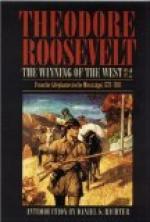About seven o’clock [Footnote: Clark’s letter to Henry.] Clark entered the town, and at once pushed his men on to attack the fort. Had he charged he could probably have taken it at once; for so unprepared were the garrison that the first rifle shots were deemed by them to come from drunken Indians. But of course he had not counted on such a state of things. He had so few men that he dared not run the risk of suffering a heavy loss. Moreover, the backwoodsmen had neither swords nor bayonets.
Most of the creole townspeople received Clark joyfully, and rendered him much assistance, especially by supplying him with powder and ball, his own stock of ammunition being scanty. One of the Indian chiefs [Footnote: A son of the Piankeshaw head-chief Tabae.]offered to bring his tribe to the support of the Americans, but Clark answered that all he asked of the red men was that they should for the moment remain neutral. A few of the young Creoles were allowed to join in the attack, however, it being deemed good policy to commit them definitely to the American side.
The Attack on the Fort.
Fifty of the American troops were detached to guard against any relief from without, while the rest attacked the fort: yet Hamilton’s scouting party crept up, lay hid all night in an old barn, and at daybreak rushed into the fort. [Footnote: Hamilton’s Narrative. Clark in his “Memoir” asserts that he designedly let them through, and could have shot them down as they tried to clamber over the stockade if he had wished. Bowman corroborates Hamilton, saying: “We sent a party to intercept them, but missed them. However, we took one of their men, ... the rest making their escape under the cover of the night into the fort.” Bowman’s journal is for this siege much more trustworthy than Clark’s “Memoir.” In the latter, Clark makes not a few direct misstatements, and many details are colored so as to give them an altered aspect. As an instance of the different ways in which he told an event at the time, and thirty years later, take




